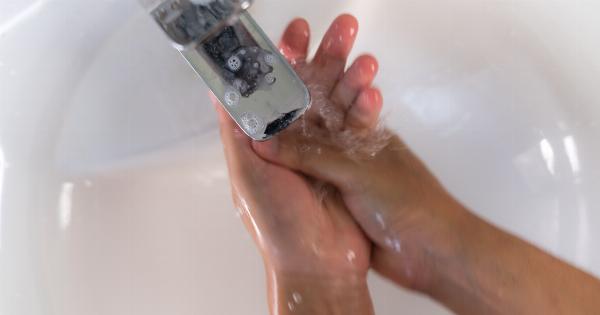Urinary Tract Infections (UTIs) are a common health issue, especially among women.
These infections occur when bacteria enters the urinary tract and multiplies, leading to uncomfortable symptoms such as frequent urination, pain or burning during urination, and cloudy or bloody urine. While various factors contribute to UTIs, staying hydrated by drinking an adequate amount of water is crucial for preventing and managing this condition.
In this article, we will explore the importance of drinking water for UTI prevention and discuss how much water is enough to keep these infections at bay.
The Role of Water in UTI Prevention
Water is essential for our overall health, and it plays a vital role in preventing UTIs as well. Here’s why:.
1. Flushing Out Bacteria
Drinking sufficient water helps in flushing out harmful bacteria from the urinary tract. When you drink enough water, the frequent urination helps to eliminate bacteria and prevent its accumulation in the urinary system.
2. Diluting Urine
By keeping yourself adequately hydrated, you can dilute your urine. When urine is diluted, it reduces the concentration of bacteria and other irritants, making it less likely for infections to occur.
3. Supporting Immune Function
Water is essential for maintaining a strong immune system. When you are well-hydrated, your immune system is better equipped to fight off infections, including UTIs. Staying hydrated ensures your body’s defense mechanisms are functioning optimally.
How Much Water is Enough?
Now that we understand why drinking water is essential for UTI prevention, let’s talk about how much water you should be drinking to keep these infections away.
The adequate water intake varies depending on several factors, such as age, sex, weight, activity level, and overall health. However, a general guideline is to aim for around 8-10 cups (64-80 ounces) of water per day.
This may seem like a lot, but keep in mind that it includes all fluids consumed, not just plain water. Other beverages, such as herbal teas, unsweetened fruit juices, and milk, also contribute to your overall fluid intake.
Additionally, consuming fruits and vegetables with high water content can also contribute to your hydration. These include watermelon, cucumbers, strawberries, and oranges.
It’s important to note that your water intake may need to be adjusted based on specific factors. For example:.
1. Activity Level
If you engage in rigorous physical activity or exercise frequently, you may need to consume more water to compensate for the additional fluid loss through sweat.
2. Climate
In hot and humid climates, you may sweat more and require extra hydration to prevent dehydration. Make sure to increase your fluid intake accordingly.
3. Medical Conditions
Some medical conditions, such as urinary incontinence or certain kidney conditions, may require you to modify your fluid intake. It is best to consult with a healthcare professional for personalized advice.
Signs of Adequate Hydration
Drinking an adequate amount of water is one thing, but how can you tell if you are properly hydrated? Here are some signs that indicate you are drinking enough fluids:.
1. Clear Urine
If your urine is pale yellow or clear, it indicates that you are adequately hydrated. Dark yellow urine may suggest dehydration, so make sure to increase your water intake if this is the case.
2. Frequency of Urination
If you urinate approximately every 2-4 hours, it is a good indication that you are drinking enough fluids to keep your urinary tract healthy.
3. Feeling Thirsty
Although thirst may not always be the most reliable indicator, it can suggest that you need to drink more fluids. It’s best to sip water throughout the day rather than relying solely on thirst cues.
Additional Tips for Preventing UTIs
In addition to staying hydrated, there are other measures you can take to reduce your risk of UTIs:.
1. Practice Good Hygiene
Always wipe from front to back after using the bathroom to prevent bacteria from the anal area from reaching the urethra.
2. Urinate Before and After Sexual Activity
Emptying your bladder before and after sexual activity can help flush out any bacteria that may have entered the urethra during intercourse.
3. Avoid Irritants
Minimize your consumption of potential bladder irritants such as caffeine, alcohol, spicy foods, and carbonated beverages, as they can worsen UTI symptoms.
4. Wear Breathable Clothing
Choose underwear made of breathable fabrics like cotton and avoid tight-fitting pants to prevent moisture buildup that can promote bacterial growth.
When to Seek Medical Attention
Although prevention measures can significantly reduce the risk of UTIs, they can still occur. If you experience persistent UTI symptoms or suspect you have a UTI, it is important to seek medical attention.
A healthcare professional can diagnose the infection and provide appropriate treatment, typically in the form of antibiotics. UTIs left untreated can lead to complications, so it’s essential to address them promptly.
Conclusion
Drinking an adequate amount of water is a simple yet effective strategy for preventing UTIs. By staying well-hydrated, you can help flush out bacteria, dilute urine, and support your immune system’s ability to fight off infections.
While the general guideline is around 8-10 cups of water per day, it’s important to adjust this based on individual factors. Pay attention to signs of adequate hydration, and remember to incorporate other fluids and water-rich foods in your diet.
Combined with good hygiene practices and other preventive measures, sufficient water intake plays a key role in keeping UTIs at bay.































